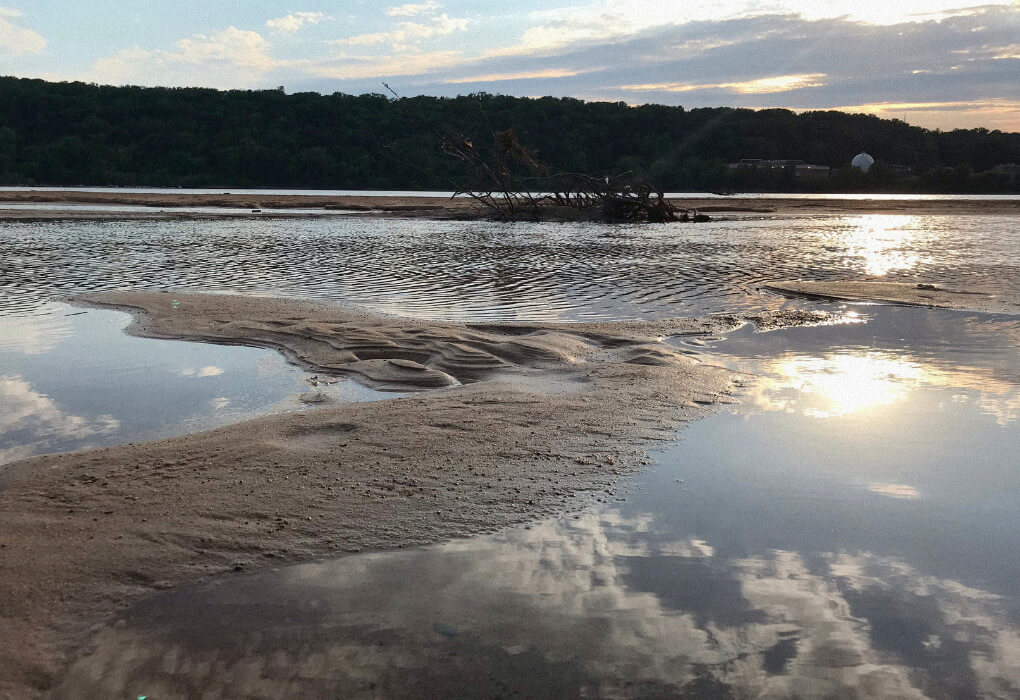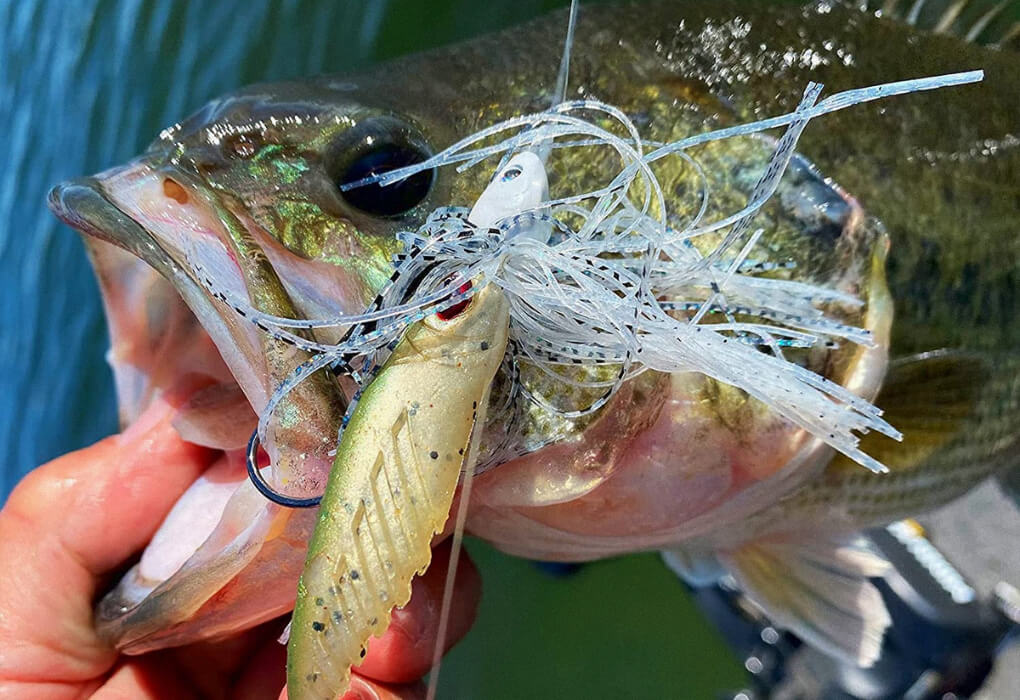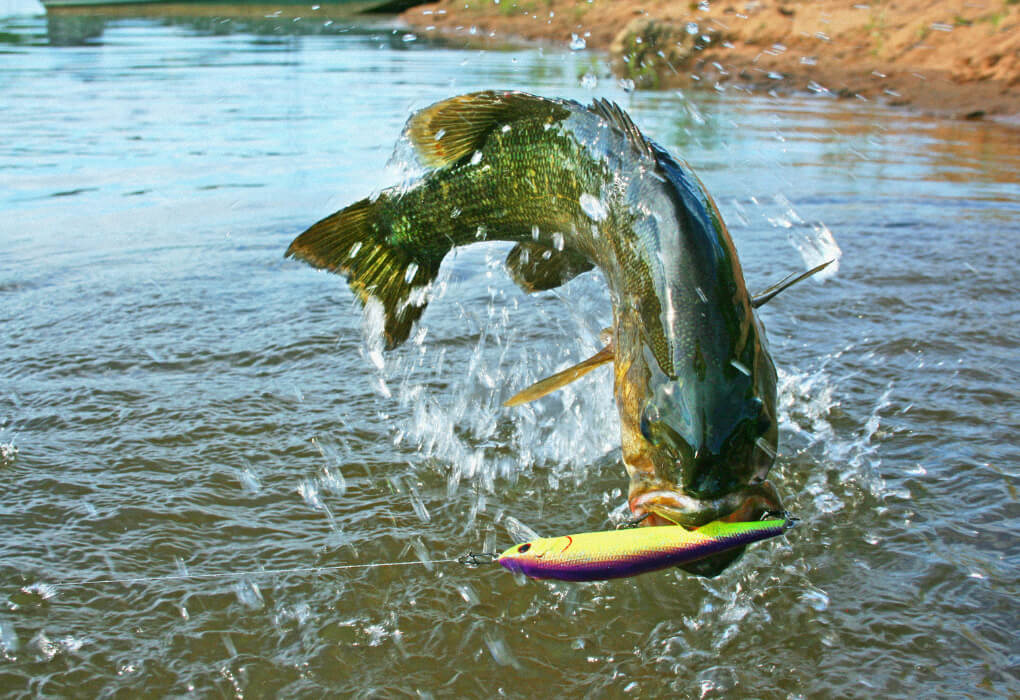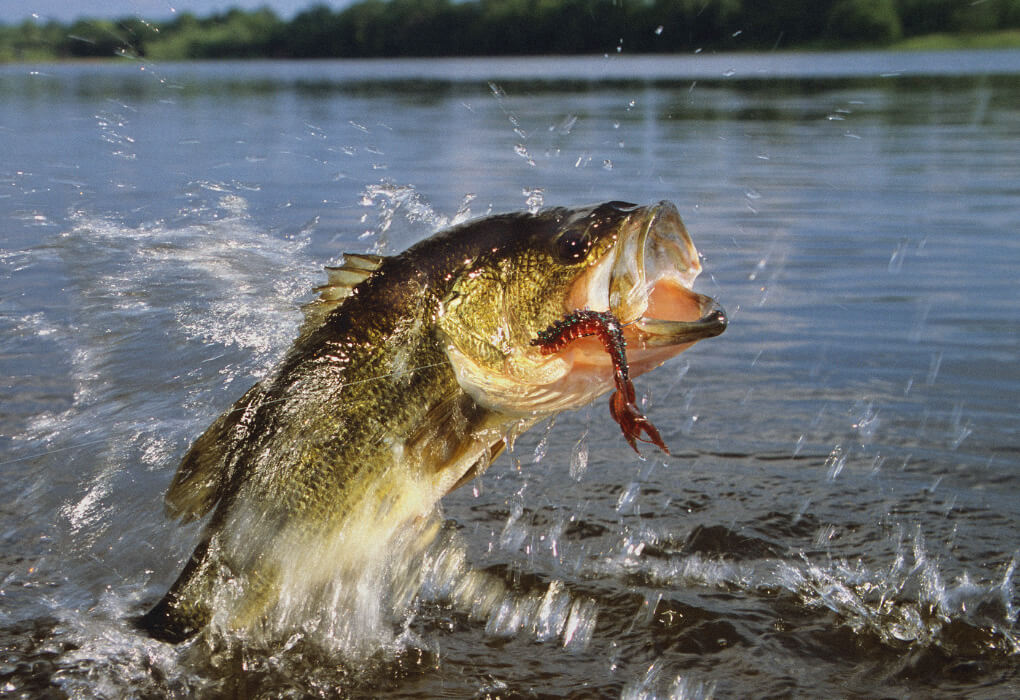I’ve always felt at home river fishing for bass. Whether fishing from the bank, kayak, or bass boat, I know there are only so many places a bass can hide in a river.
After years of bass fishing in rivers and learning from other bass anglers, I’ve compiled many river bass fishing tips that I’ll happily share with you so that you can catch more bass on your next river fishing adventure.
Let’s start with understanding where bass spend most of their time in rivers.
Anglers.com writer, Wes Littlefield asked some of the Major League Fishing Pros for River fishing tips, and the YouTube video above is how they answered!
Where are Bass in Rivers?

No matter if you’re fishing on a giant river like the mighty Mississippi River or a small river with no name, you’ll always find bass in at least one of four places; around structure, current breaks, deep holes, and the backwaters.
Structure
Structure is a broad term that can mean many different things. Brush piles, docks, rock piles, laydowns, and main channel ledges are all considered structures.
Much like lakes, bass relate to structure in a river because it provides cover, a place to hide from prey and predator, and breaks the current.
You’ll notice that most other fish species also relate to these structures, so a bass doesn’t have to go far to find a meal when hanging out around these areas.
Current Breaks

Current breaks are one of my favorite places to fish. If I see a current break, chances are I’m going to cast into it at least a couple of times.
I consider a current break anything that slows or changes the direction of the current. A current break could be boulders, pylons, trees, stumps, sandbars, wing dams, or river channel swings.
Most of the time, they’re visible eddies on the water’s surface. You’ll see swirls or the current going around the object. Other times they’re less visible because they’re fully submerged.
Current breaks are one of my favorite places to fish because bass often hide behind them (downstream), so they use less energy before they ambush their prey.
If you’ve ever tried to swim against the current, you understand how much energy it takes to move forward, even a little bit.
Though bass are better suited for this, they still don’t want to waste energy, and sitting in a current break is the best way to do that.
Holes
Holes are a relative term based on your location. In some rivers I fish, a hole is only 4-5 feet of water, while in other rivers, a hole is 10-20+ feet deep.
Bass like to spend a lot of time in holes because the water tends to slow down in these areas. Since the current isn’t moving as fast, they don’t spend as much energy searching for food.
Another reason bass prefer a deep hole is to escape predators. If they feel endangered, they have more room to move and hide than in shallow portions of the river.
The main river channel can also be considered a hole. I suggest finding structure and a ledge or drop-off when fishing the main channel.
Backwaters
In the spring and early summer, rivers tend to flood and create backwaters. Bass will follow the water as it floods these areas in search of food.
Backwaters are not easy to fish because you must deal with standing timber and shallow waters. If you catch the water rising, you can have a great day of bass fishing on the river, even from the bank.
In backwaters, bass most often relate to trees and other woody vegetation. Determining what trees hold the most fish will increase your chances of success.
On my local rivers backwaters, flipping willow trees with a spinnerbait or jig works well when the water is rising.
Bass Fishing River Presentations
There is no special presentation that will always get bass to bite, but generally, I stick with moving baits in the river.
A power fishing presentation will typically yield the best results when there is a slight current because bass are more active in the current.
When fishing in the backwaters, slower finesse presentations will work well because less current flows through the area, so you need less commotion to get the bass’s attention.
How and where you present your lure is very important. Remember I said bass spend most of their time behind a current break?
You need to get your lure into that current break.
This means you’ll need to make a good cast and bring your lure through that area where the bass doesn’t have to do much work to bite it.
Intentionally bumping your lure into the structure, imitating an injured baitfish, often triggers bites.
Best Lures for River Bass Fishing

The best river bass lures have a lot of action to help bass find them in turbulent or muddy water. Buzzbaits, spinnerbaits, crankbaits, jigs, and Texas rigs are typically the top performers.
A spoon is one of the best lures for river largemouth bass that’s often overlooked. The flutter of the spoon looks like a struggling shad, and the bass can’t help but bite the easy meal.
A jig and Texas rig work well in backwater areas out of the current. You can pitch and flip a jig to standing trees or do the same with a pegged Texas rig.
The best way to catch bass in a river is not to get stuck using one lure if it’s not working; just like any other fishery, bass will want different presentations and lures throughout the day.
Choosing the color of your baits and bass lures for river fishing will depend mainly on water clarity. For clear water, use translucent or natural colors; for dirty water, use black and blue or bright colors like chartreuse.
River Bass Habits
Like in lakes and reservoirs, bass have habits in rivers we can focus on when fishing. The time of year, water level, and speed of the current have a significant role to play in where bass will be and when they’ll be there.
In the spring, bass are looking to spawn, so they’ll find shallow water to build a nest. As early summer begins, they move to deeper water in search of food.
By late summer, they’ve discovered deep water to stay cool and hide from predators.
As fall begins, bass will feed heavily for winter and follow the baitfish back to the shallows. During the winter, they’ll move back to the deep water to protect against frigid temperatures.
While all this is happening, the changing water levels and current speeds also potion bass in different locations.
If the water is rising and the current is strong, bass will head to the bank in search of a current break, and if the water drops, they’ll head to the deeper holes.
Bass feed on crawfish, insect larvae, minnows, and other baitfish in rivers. Imitating these creatures with your lures will yield the best results.
How to Fish For Smallmouth Bass in Rivers

Smallmouth river fishing is a blast because bronzebacks are known for being hard-fighting fish, using the current to their advantage.
Many times, I’ve hooked a small bass and thought it was much larger because of the current.
Remembering to downsize your lure when fishing for smallies in a river is a great place to start. Smallmouth are called smallmouth for a reason, and having too big of a lure will cost you fish.
There are two primary methods for catching river smallies. You can stay upstream of them or downstream.
I prefer to fish downstream most of the time because the bass don’t have to fight against the current as hard to get my lure, so in theory, they’ll be more willing to bite.
However, sometimes river smallmouth prefers to ambush the lure as it’s swimming upstream.
One of the best places to try this approach is after some riffles where the river goes from very shallow to a deep pool.
Smallmouth are a schooling species, so if you catch one, there will likely be others in the area. They’re more likely to be found in moving water than largemouth bass and tend to relate to rocks more than wood.
Bass Fishing in Rivers for Largemouth Bass

Largemouth also inhabit river systems. Sometimes you’ll catch smallmouth and largemouth side-by-side, but that’s not very common. Most of the time, you’ll need to target them separately using similar techniques.
Largemouth are not as aggressive as smallmouth, so sometimes you must adjust your approach and use soft plastic lures and slower techniques when targeting them.
If you want to catch big bass, then increasing the size of your lure will help weed out the small bites, but you’ll also catch fewer fish. Since largemouths have a big mouth, they can handle a bigger lure.
Largies spend more time relating to wood than smallmouths, especially in the backwater areas. They’re also less fond of the current and will be more along the shorelines in current breaks.
Frequently Asked Questions
Below you’ll find some of the most commonly asked questions about fishing rivers for bass.
Where do bass hide in rivers?
Bass hide in rivers in a few places; current breaks, around structure, holes, and flooded backwaters.
Can you catch Largemouth bass in rivers?
Yes, you can catch largemouth bass in rivers. When you know where to fish, catching largemouth bass in rivers can be easier than fishing in a lake.
What are the dangers of river fishing for bass?
The current is the biggest danger of river fishing for bass. A slow current is strong enough to quickly carry you downriver or pin you against a log, rock, or piling.
What are the advantages of fishing for bass in rivers?
The advantages of fishing for bass in rivers are you don’t have as much water to cover because there are fewer places the bass can be, bass tend to stick to a more predictable pattern in rivers, and moving baits tend to work more often.
Final Cast
In my opinion, river fishing for bass is less complicated than bass fishing in a lake, where the bass have many more places to go.
Bass will often relate to current breaks in the river, which is why I usually begin there. Now that you know how to fish rivers for bass, I can’t wait to hear about your river fishing adventures!
Tell me about your latest river bass fishing trip in the comment section!




